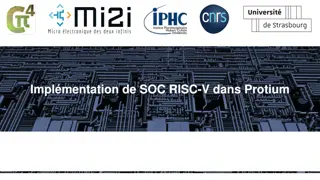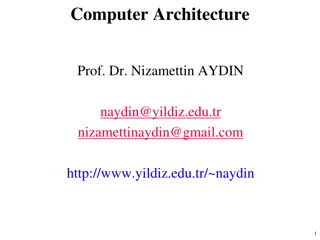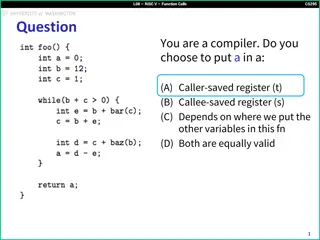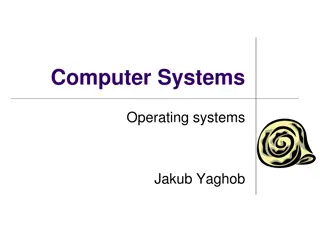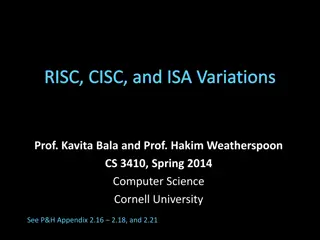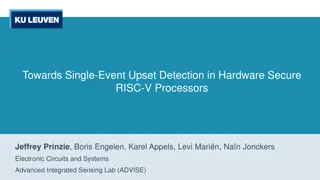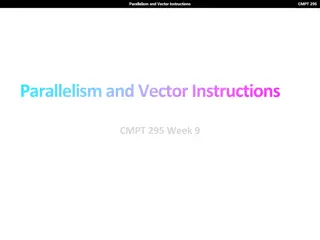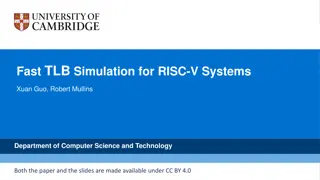Evolution of Computing Architectures: RISC Approach
Study on the RISC approach in computing architecture, focusing on key characteristics and advancements since the inception of stored-program computers. Topics covered include the family concept, microprogrammed control units, cache memory, pipelining, and the development of RISC architecture as an alternative to the traditional CISC design.
Download Presentation

Please find below an Image/Link to download the presentation.
The content on the website is provided AS IS for your information and personal use only. It may not be sold, licensed, or shared on other websites without obtaining consent from the author. Download presentation by click this link. If you encounter any issues during the download, it is possible that the publisher has removed the file from their server.
E N D
Presentation Transcript
Eastern Mediterranean University School of Computing and Technology Master of Technology Chapter 1 Chapter 15 5 Reduced Instruction Set Computers (RISC) Reduced Instruction Set Computers (RISC)
After studying this chapter, you should be able to: Provide an overview research results on instruction execution characteristics that motivated the development of the RISC approach. Summarize the key characteristics of RISC machines. Discuss the implication of a RISC architecture for pipeline design and performance. 2
Since the development of the stored-program computer around 1950, there have been remarkably few true innovations in the areas of computer organization and architecture. The following are some of the major advances since the birth of the computer The family concept Microprogrammed control unit Cache memory Pipelining Computer Evolution Multiple processors Reduced instruction set computer (RISC) architecture 3
The family concept: The family concept decouples the architecture of a machine from its implementation. A set of computers is offered, with different price/performance characteristics, that presents the same architecture to the user. The differences in price and performance are due to different implementations of the same architecture. It was first introduced by IBM in 1964. Microprogrammed control unit: Suggested by Wilkes in 1951 and introduced by IBM in 1964. Microprogramming eases the task of designing and implementing the control unit and provides support for the family concept. 4
Cache memory: First introduced commercially by IBM in 1968. The insertion of this element into the memory hierarchy dramatically improves performance. Pipelining: Different stages of different instructions are executed simultaneously. For example instruction pipelining Multiple processors: This category covers a number of different organizations and objectives. Multiple processors can handle different parts of the same job. Memory sharing is possible. Different caches can be used for each CPU. 5
Reduced instruction set computer (RISC) architecture: This is the focus of this chapter . It was developed as an alternative to the CISC architecture. Basic properties are as follows; What are some typical distinguishing characteristics of RISC organization? (1) a limited instruction set with a fixed format, (2) a large number of registers (3) the use of a compiler that optimizes register usage, and (3) an emphasis on optimizing the instruction pipeline 6
Characteristics of some CISC, RISC, and superscalar processors are given below. 7
1. Driving force for CISC 1.Instruction Execution Characteristics Instruction Execution Characteristics One of the most visible forms of evolution associated with computers is that of programming languages. As the cost of hardware has dropped, the relative cost of software has risen Thus, the major cost in the life cycle of a system is software, not hardware. 8
This solution gave rise to a perceived problem, known as the semantic gap, the difference between the operations provided in HLLs and those provided in computer architecture. 9
What are the symptoms of semantic gap? Symptoms of this gap are alleged to include execution inefficiency, excessive machine program size, and compiler complexity. 10
Designers responded with architectures intended to close this gap. Key features are; include large instruction sets, dozens of addressing modes, and various HLL statements implemented in hardware. What is the purpose of developing complex instruction sets ? ( Intention of CISC) Ease the task of the compiler writer. Improve execution efficiency, because complex sequences of operations can be implemented in microcode. Provide support for even more complex and sophisticated HLLs. 11
The various programs in High level languages are analyzed in CISC computers. Let us review these analyzes; Operations performed: These determine the functions to be performed by the processor and its interaction with memory. Operands used: The types of operands and the frequency of their use determine the memory organization for storing them and the addressing modes for accessing them Execution sequencing: This determines the control and pipeline organization 13
Operations Assignment statements predominate, suggesting that the simple movement of data is of high importance. i.e data movement instructions Conditional statements (IF, LOOP). These statements are implemented in machine language with some sort of compare and branch instruction. This suggests that the sequence control mechanism of the instruction set is important. 14
The questions for the machine instruction set designer is that: Given a compiled machine language program, which statements in the source language cause the execution of the most machine-language instructions? To get at this underlying phenomenon, the Patterson programs [PATT82a] were compiled on the VAX, PDP-11, and Motorola 68000 to determine the average number of machine instructions and memory references per statement type. 15
Weighted Relative Dynamic Frequency of HLL Operations Weighted Relative Dynamic Frequency of HLL Operations 16
The second and third columns in the table shows the relative frequency of occurrence of various HLL instructions in a variety of programs. To obtain the data in columns four and five (machine second and third columns is multiplied by the number of machine instructions produced by the compiler. These results are then normalized so that columns four and five show the relative frequency of occurrence, weighted by the number of machine instructions per HLL statement. machine- -instruction weighted instruction weighted), each value in the 17
Similarly, the sixth and seventh columns are obtained by multiplying the frequency of occurrence of each statement type by the relative number of memory references caused by each statement. The data in columns four through seven provide measures of the actual time spent executing the various statement types. The results suggest that the procedure call/return is the most time consuming operation in typical HLL programs. actual time spent executing the various statement types. The results suggest that the procedure call/return is the most time consuming operation in typical HLL programs. 18
The Patterson also looked at the dynamic frequency of occurrence of classes of variables. The results show that the majority of references are to simple scalar variables. Dynamic Percentage of Operands Dynamic Percentage of Operands 19
Procedure Calls We have seen that procedure calls and returns are an important aspect of HLL programs. The evidence (From Tables ) suggests that these are the most time-consuming operations in compiled HLL programs. Procedure Calls Thus, it will be profitable to consider ways of implementing these operations efficiently. Two aspects are significant for the procedure calls: (i)the number of parameters and variables that a procedure deals with, and (ii) the depth of nesting. 20
Implications Generalizing from the work of a number of researchers Implications 1. Use a large number of registers or use a compiler to optimize register usage. ( i.e quick access to operands) This is intended to optimize operand referencing. This, coupled with the locality and predominance of scalar references, suggests that performance can be improved by reducing memory references at the expense of more register references. Because of the locality of these references, an expanded register set seems practical. 21
2. Careful attention needs to be paid to the design of instruction pipelines Because of the high proportion of conditional branch and procedure call instructions, 3. An instruction set consisting of high- performance primitives .e.g RISC 22
2. 2.The Use of a Large Register File The Use of a Large Register File The results summarized in previous section point out the desirability of quick access to operands. We have seen that there is a large proportion of assignment statements in HLL programs, and many of these are of the simple form A B. The reason that register storage is indicated is that it is the fastest available storage device, faster than both main memory and cache The register file is physically small, on the same chip as the ALU and control unit, and employs much shorter addresses than addresses for cache and memory. 23
Thus, a strategy is needed that will allow the most frequently accessed operands to be kept in registers and to minimize register-memory operations. Briefly explain the two basic approaches used to minimize register-memory operations on RISC machine Two basic approaches are possible, one based on software and the other on hardware. The software approach is to rely on the compiler to maximize register usage. The compiler will attempt to assign registers to those variables that will be used the most in a given time period. This approach requires the use of sophisticated program-analysis algorithms. The hardware approach is simply to use more registers so that more variables can be held in registers for longer periods of time. 24
The use of a large set of registers should decrease the need to access memory. The design task is to organize the registers in such a fashion that this goal is realized. The problem is that the definition of local changes with each procedure call and return, operations that occur frequently. How registers are used in procedure call and return opertaions? On every call, local variables must be saved from the registers into memory, so that the registers can be reused by the called procedure. On return, the variables of the calling procedure must be restored (loaded back into registers) and results must be passed back to the calling procedure 25
3.Reduced Instructions Set Architecture 3.Reduced Instructions Set Architecture Why CISC ? There is a trend to richer instruction sets which include a larger and more complex number of instructions Two principal reasons for this trend: A desire to simplify compilers A desire to improve performance simplify compilers improve performance 26
It is not the intent of this chapter to say that the CISC designers took the wrong direction. Simply meant to point out some of the potential pitfalls in the CISC approach and to provide some understanding of the motivation of the RISC adherents. The first of the reasons cited, compiler simplification. The task of the compiler writer is to build a compiler that generates good sequences of machine instructions for HLL programs (i.e., (fast, small, fast and small) If there are machine instructions that resemble HLL statements, this task is simplified. 27
RISC researchers found that complex machine instructions are often hard to exploit because the compiler must find those cases that exactly fit the construct. The task of optimizing the generated code to minimize code size, reduce instruction execution count, and enhance pipelining is much more difficult with a complex instruction set. As a evidence of studies cited earlier shows that most of the instructions in a compiled programs are the relatively simple ones. The other major reason cited is the expectation that a CISC will yield smaller, faster programs. Let us examine both aspects of this assertion that programs will be smaller and that they will execute faster. 28
There are two advantages to smaller programs : 1. The program takes up less memory There is a savings in that resource. 2. Should improve performance in three ways Fewer instructions means fewer instruction bytes to be fetched In a paging environment smaller programs occupy fewer pages, reducing page faults More instructions fit in cache(s) takes up less memory improve performance. This will happen 29
The problem with this line of reasoning is that it is far from certain that a CISC program will be smaller than a corresponding RISC program. In many cases, the CISC program, expressed in symbolic machine language, may be shorter (i.e., fewer instructions), but the number of bits of memory occupied may not be noticeably smaller. 30
There are several reasons for these rather surprising results. CISCs tend to favor simpler instructions, so that the conciseness of the complex instructions seldom comes into play. There are more instructions on a CISC, longer opcodes are required, producing longer instructions. Finally, RISCs tend to emphasize register rather than memory references, and the former require fewer bits. 31
The second motivating factor for increasingly complex instruction sets was that instruction execution would be faster. The entire control unit must be made more complex, and/or The microprogram control store must be made larger, to accommodate a richer instruction set Either factor increases the execution time of the simple instructions 32
Characteristics of Reduced Instruction Set Architectures Characteristics of Reduced Instruction Set Architectures Machine cycle is the time it takes to fetch two operands from registers, perform an ALU operation, and store the result in a register. One machine instruction per machine cycle With one-cycle instructions, there is little or no need for microcode; the machine instructions can be hardwire;. Such instructions should execute faster than comparable machine instructions on other machines, because it is not necessary to access a microprogram control store during instruction execution 33
Only simple LOAD and STORE operations accessing memory. This simplifies the instruction set and therefore the control unit. Register-to- register operations A second characteristic is that most operations should be register to register, with only simple LOAD and STORE operations accessing memory. This design feature simplifies the instruction set and therefore the control unit. 34
Simple addressing modes Simplifies the instruction set and the control unit Almost all RISC instructions use simple register addressing. Several additional modes, such as displacement and PC- relative, may be included. Other, more complex modes can be synthesized in software from the simple ones. Again, this design feature simplifies the instruction set and the control unit. 35
Simple instruction formats Generally only one or a few formats are used Instruction length is fixed and aligned on word boundaries. Opcode decoding and register operand accessing can occur simultaneously. This design feature has a number of benefits. With fixed fields, opcode decoding and register operand accessing can occur simultaneously. Simplified formats simplify the control unit. Instruction fetching is optimized because word-length units are fetched. Alignment on a word boundary also means that a single instruction does not cross page boundaries 36
In the table, the first eight processors are clearly RISC architectures, the next five are clearly CISC, and the last two are processors often thought of as RISC that in fact have many CISC characteristics. 38
In RISC architectures, most instructions are register to register, and an instruction cycle has the following two stages: I: Instruction fetch E: Execute input and output) For load and store operations, three stages are required: I: Instruction fetch E: Execute D: Memory register operation) Instruction fetch. Execute (Performs an ALU operation with register three stages are required: Instruction fetch. Execute (Calculates memory address) Memory (Register-to-memory or memory-to- 39
Figure (a) depicts the timing of a sequence of instructions using no pipelining. Clearly, this is a wasteful process. Even very simple pipelining can substantially improve performance. 40
Figure (b) shows a two-stage pipelining scheme, in which the I and E stages of two different instructions are performed simultaneously. It is assumed that a single- port memory is used and that only one memory access is possible per stage So E and D can not be done simultaneously. only one memory access is possible per stage. NOOP: No Operation 41
We see that the instruction fetch stage of the second instruction can be performed in parallel with the first part of the execute/ memory stage. However, the execute/memory stage of the second instruction must be delayed until the first instruction clears the second stage of the pipeline. This scheme can yield up to twice the execution rate of a serial scheme 42
Two problems prevent the maximum speedup from being achieved. 1. First, we assume that a single port memory is used and that only one memory access is possible per stage. This requires the insertion of a wait state in some instructions. 2. Second, a branch instruction interrupts the sequential flow of execution. To accommodate this with minimum circuitry, a NOOP instruction can be inserted into the instruction stream by the compiler or assembler 43
Pipelining can be improved further by permitting two memory accesses per stage which is shown in Figure (c). 44
Now, up to three instructions can be overlapped, and the improvement is as much as a factor of 3. Again, branch instructions cause the speedup to fall short of the maximum possible. Also, note that data dependencies have an effect. If an instruction needs an operand that is altered by the preceding instruction, a delay is required. Again, this can be accomplished by a NOOP. 45
Figure (d) shows the result with a four-stage pipeline. Since E stage usually involves an ALU operation, it may be longer other E E1 1- -Register file read E E2 2-ALU operation and register write longer than than other stages stages. In this case, we can divide into two substages: 46
Up to four instructions at a time can be under way, and the maximum potential speedup is a factor of 4. Note again the use of NOOPs to account for data and branch delays NOOP: No Operation 47
Because of the simple and regular nature of RISC instructions, pipelining schemes can be efficiently employed. There are few variations in instruction execution duration, and the pipeline can be tailored to reflect this. However, data and branch dependencies reduce the overall execution rate. 48
To compensate for these dependencies, code reorganization techniques have been developed. Delayed branch A way of increasing the efficiency of the pipeline, makes use of a branch that does not take effect until after execution of the following instruction (hence the term delayed). The instruction location immediately following the branch is referred to as the delay slot. 49
After 102 is executed, the next instruction to be executed is 105. To regularize the pipeline, a NOOP is inserted after this branch. However, increased performance is achieved if the instructions at 101 and 102 are interchanged. 50



